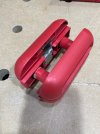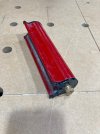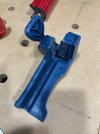Just from reading internet reviews, I'm leaning toward a single sided cutter that cuts forward or backward. What is your preferred method for trimming a lot of self gluing wood edging?
You are using an out of date browser. It may not display this or other websites correctly.
You should upgrade or use an alternative browser.
You should upgrade or use an alternative browser.
What's your favorite cutter for edge banding?
- Thread starter Tim Sherwood
- Start date
That’s what I have used in the past but the edge was never quite clean enough did me and was prone to tear out. Maybe user error but the way I do it now is trim close with a razor or veneer saw and follow up a flush trim router bit. I had good luck with a laminate file as well but can get clogged up with glue.
I tried a flush trim router bit. I had trouble holding it at a pure 90 angle. That resulted in a few bald spots, where the bit removed some ot the plywood face veneer. I could gang a couple of boards together for better stability. But that would slow down the process a lot. Once I got the bulk of the edging close, I liked the way a file smoothed the edges.
I have used this for iron-on edge banding for about 30 years. Nothing else that I have tried has worked as well. Also use draw filing to smooth the cut edge. Looks like it is still available:


Edgebanding Trimmers - Cabinet Hand Tools - Cabinet Tools & Clamps
Edgebanding Trimmers Hand Tools cabinet supply. Check out our selection of Tools & Clamps cabinet supplies.We also have kitchen cabinets, cabinet storage, bathroom cabinets supplies.
www.cabinetmakerssupply.com
Fastcap also makes a hand edge band trim tool much like pop-pop shows. I’ve used several of them. You will experience tear out on wood edge banding when you run against the grain just like running a hand plane or any cutting tool against the grain. A trim router will work and yes sometimes you have to slow down the process to get the quality you want. I have done it both ways and still have had to file and sand the areas to get the finish that is desired. Good luck!
Some great ideas. Thanks for the advice. Like most woodworking tasks, there are several ways to do the job.
Jeff, I have used a 10" mill file and it shears of the excess nicely. But I'm hoping to find something quicker to do 100 feet.
I quit using blade trimmers on wood. Now all I do is use a file the side of the file cuts off the banding with no tear out and is fast. Follow with sandpaper glued to a block of wood about 3x8”. Final is burnish the edge with an old broom handle.Just from reading internet reviews, I'm leaning toward a single sided cutter that cuts forward or backward. What is your preferred method for trimming a lot of self gluing wood edging?
Works really well and fast NO tear out
I find that those trimmers that slide down the edge produce a poor quality edge. Router trimmers also the same. I can absolutely finish an edge quicker with a manual file than either of those methods and with better quality. Place the file in a vertical position and "saw" straight down and forward while keeping the file in contact with the work piece and only cut in the down stroke motion. You will quickly get the hang of it and not go back to router bits and razor blades. I hope this helps.Jeff, I have used a 10" mill file and it shears of the excess nicely. But I'm hoping to find something quicker to do 100 feet.
I have done 100s of feet of glue on edge banding with the following three tools. These work well for Melamine, finished and unfinished wood.
The thing you have to remember when trimming wood edge banding is that you are planing wood and you always trim/plane grain down hill.
You have to read the grain before trimming. Sometimes you can trim both sides in the same direction, sometimes trim each side in different directions and then some times you have to change directions on each side.
I found I got the best results with two passes, first pass removes most of the waste with the second pass removing the rest of the wood and glue squeeze out.
After trimming one or two passes with the sander leaves a slight bevel which helps prevent lifting the banding. If you are spraying a finish the bevel allows the finish to flow and seal better. I put a slight bevel on the ends with a 150 grit sanding block after trimming it with the Guillotine trimmer. Plan on trowing away some banding. I cut around the joints in the banding and any sections with gnarly grain. Here again two cuts gives a better result that one.
When ironing the banding on I use a clothing iron set at its max temp. I heat up the panel edge first with the iron. The warm panel edge will kinda grab the banding glue. Then I heat the entire strip moving the iron back and forth until the wood is hot to the touch. Then I run a small diameter rod at an angle flat on the edge back and forth on the banding until the glue sets. I use my scrapper burnisher for this but a large round screw driver will also work. I wait till the glue has cooled to trim the the banding. That way 99% of the glue will come off with the rimming.
I will not use the Sanur banding I get mine from Edgeco. I think their glue is better.
Fastcap pro double bidirectional sided squeeze adjustable width. I bought the yellow thing Klingspoor sells or used to sell and threw it away.

Fastcap edge band sander. Sanding a slight bevel will ease finishing and help prevent lifting of the banding.

Guillotine trimer for ends. I got this one from Amazion.

The thing you have to remember when trimming wood edge banding is that you are planing wood and you always trim/plane grain down hill.
You have to read the grain before trimming. Sometimes you can trim both sides in the same direction, sometimes trim each side in different directions and then some times you have to change directions on each side.
I found I got the best results with two passes, first pass removes most of the waste with the second pass removing the rest of the wood and glue squeeze out.
After trimming one or two passes with the sander leaves a slight bevel which helps prevent lifting the banding. If you are spraying a finish the bevel allows the finish to flow and seal better. I put a slight bevel on the ends with a 150 grit sanding block after trimming it with the Guillotine trimmer. Plan on trowing away some banding. I cut around the joints in the banding and any sections with gnarly grain. Here again two cuts gives a better result that one.
When ironing the banding on I use a clothing iron set at its max temp. I heat up the panel edge first with the iron. The warm panel edge will kinda grab the banding glue. Then I heat the entire strip moving the iron back and forth until the wood is hot to the touch. Then I run a small diameter rod at an angle flat on the edge back and forth on the banding until the glue sets. I use my scrapper burnisher for this but a large round screw driver will also work. I wait till the glue has cooled to trim the the banding. That way 99% of the glue will come off with the rimming.
I will not use the Sanur banding I get mine from Edgeco. I think their glue is better.
Fastcap pro double bidirectional sided squeeze adjustable width. I bought the yellow thing Klingspoor sells or used to sell and threw it away.

Fastcap edge band sander. Sanding a slight bevel will ease finishing and help prevent lifting of the banding.

Guillotine trimer for ends. I got this one from Amazion.

That's a great description of your banding process Micheal. I'll be trying out all the suggestions in this posting. Banding is on my schedule today.
This is the link to Edgeco banding. Edgebanding Colors Matching PVC Edge Banding - Edge TapeEdgeCo, Inc.
I get there 15/16 banding. I have used the .5 mm and 1 mm.
I get there 15/16 banding. I have used the .5 mm and 1 mm.
I put your suggestions to work yesterday. I worked through about 5o feet of Maple banding on plywood. The quickest method was the simplest. I used the edge of a mill file to cut the excess away and then a light pass with the file face to smooth the fuzz away. But I was not really happy with the result. It left a soft, slightly rounded appearance. That could probably be improved with practice , and better technique .
Then I used the single edge cutter that pop-pop showed us. With a little patience and attention to the grain, I got a cleaner, sharper appearing edge. I did use the file very lightly , at a shallow angle , to smooth the edge. I think this will be my go-to process.
I had already tried my trim router with poor results. I couldn't hold it steady on the plywood edge, and gouged the surface veneer. I could correct that by clamping two boards together for steady support. But I don't see the need for that extra work when I liked the results from the banding cutter.
One of the things I like best about woodworking is that there are usually several ways to tackle the same task. Thanks for sharing your experiences!
Then I used the single edge cutter that pop-pop showed us. With a little patience and attention to the grain, I got a cleaner, sharper appearing edge. I did use the file very lightly , at a shallow angle , to smooth the edge. I think this will be my go-to process.
I had already tried my trim router with poor results. I couldn't hold it steady on the plywood edge, and gouged the surface veneer. I could correct that by clamping two boards together for steady support. But I don't see the need for that extra work when I liked the results from the banding cutter.
One of the things I like best about woodworking is that there are usually several ways to tackle the same task. Thanks for sharing your experiences!
LATEST FOR SALE LISTINGS
-
-
-
SOLD -- $75: Gast moa v113 Vacuum Pump Veneer, 60" bag and board
- Started by peterdnight
- Replies: 1
-
GONE: Gladiator 5 cleats, 10 hangers, Paper Towel and Shelf
- Started by peterdnight
- Replies: 3
-
SOLD -- $100 Makita mac700 portable air + grex pin nailer + 2 others + 50' hose
- Started by peterdnight
- Replies: 1

